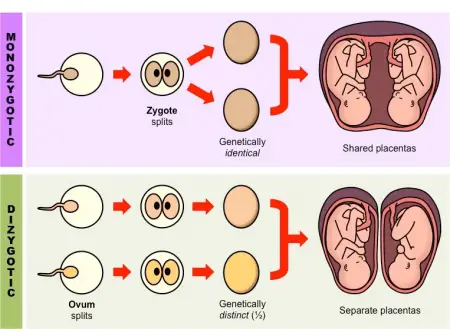Mary-Kate and Ashley Olsen may look alike, but they are actually not identical (also called monozygotic) twins. The famous twins are fraternal (or dizygotic) twins. Contrary to common knowledge, similar appearance is not the sole basis to determine whether twins are monozygotic or dizygotic. Confused? This article will discuss the difference between monozygotic and dizygotic twins.
Summary Table
| Monozygotic Twins | Dizygotic Twins |
| Developed from a single egg which was fertilized by a single sperm cell | Developed from two eggs fertilized by two different sperm cells |
| Two fetuses grow in the same placenta | Two fetuses grow in two different membranes |
| Have almost identical genetic profile | Completely different genetic profile |
| Always of the same sex | May be of the same or opposite sex |
| May have the same physical and mental characteristics | May look alike or different; may behave similarly or differently |
| Also called “identical twins” | Also called “fraternal twins” |
Descriptions

Monozygotic twins, more commonly called “identical twins,” come from the same zygote (egg) fertilized by a single sperm. This fertilized egg then splits and produces two embryos which usually have identical chromosomes. Two fetuses will grow from the two embryos inside the same placenta.
Monozygotic twins have almost identical genes and the same blood type but they are still unique individuals.
They are nearly always of the same sex although male-female monozygotic twins, an extremely rare occurrence, may result from a mutation during the early stages of development.
Identical twins do not have the same fingerprints. They may look almost the same physically and may even share the same psychological and mental characteristics.
Dizygotic twins, also known as “fraternal twins,” are produced from two zygotes or fertilized eggs that are fertilized by two different sperm cells. In other words, dizygotic twins are somewhat similar to ordinary siblings except that the former are born at the same time. They do not share the same chromosomes.
Dizygotic twins are developed in two different amniotic membranes and placenta. They may share the same genes, but only 50% of them.
They may resemble each other or may be physically different from each other. Additionally, dizygotic twins can be of the same or different sex.
Monozygotic vs Dizygotic Twins
What, then, is the difference between monozygotic and dizygotic twins?
Monozygotic twins, or “identical twins,” are developed from the same egg which is fertilized by a single sperm cell. Dizygotic twins, or “fraternal twins,” are developed from two eggs that are fertilized by two different sperm cells. Monozygotic twins are developed in one placenta whereas dizygotic twins are developed in two separate placentas.
Monozygotic twins have genetic profiles that are almost identical to each other.
They have the same blood type and may even share the same personalities. Most of the time, they are also of the same sex and share the same physical features.
On the other hand, dizygotic twins have completely different genetic profiles and are just like regular siblings. They may be of the same or different gender, and they may look alike or different.
What Causes Monozygotic and Dizygotic Twins to Occur?
The reasons for the development of monozygotic twins are not fully understood. There are some human populations where monozygotic twins are born more often; still, they are rare. So far, scientists have not been able to identify a specific gene that ensures an increased chance of bearing monozygotic twins.
However, monozygotic twins are more common in IVF pregnancies. Researchers believe that the solution embryos live in before they’re implanted may contribute to the differences. But it may also be the process of transferring the embryo from the solution to the uterus that may result in the development of monozygotic twins. One note, conjoined twins are monozygotic twins. This type of twinning is not hereditary.
Scientists have also found that the odds of conceiving fraternal twins are higher in women who are overweight or whose families have had fraternal twins.
Researchers have also found that dizygotic twins can be caused by a gene that may cause women to release two or more eggs at the same time. Dizogotic twins are also more common in older women (35 years of age and older), as well as in women who have had previous pregnancies. If the woman is a dizygotic twin, she has a higher chance of having dizygotic twins.
Dizygotic twins have different genes because they are formed from two different eggs and sperm. Even so, both babies grow within the same uterus at the same time.
Another interesting note about monozygotic and dizygotic twins is that each baby is an individual who has their own unique fingerprints.
How to Tell If Twins are Monozygotic or Dizygotic?
It’s hard to tell if twins are monozygotic or dizygotic. One method used to tell what type of twins you have is through genetic testing. Monozygotic twins share identical genetic information, while dizygotic twins share about half of their DNA. The test is easy to do and will not harm the babies. It’s done with a sample of cheek cells or blood group tests.





